The wireless specification of TP-LINK’s XDR3230 is AX3200, which is quite unusual. Other wireless routers rarely have this specification because its 2.4G is Wi-Fi 5, 4×4 MIMO, with a maximum rate of 800Mbps, while the 5G also supports 4×4 MIMO and Wi-Fi 6, achieving a maximum rate of 2402Mbps at an 80MHz bandwidth, totaling 3200. It does not support 160MHz. Due to the parameters of the 2.4G, I previously mistakenly thought it used the MT7615N or MT7611N.
Packaging of the XDR3230:
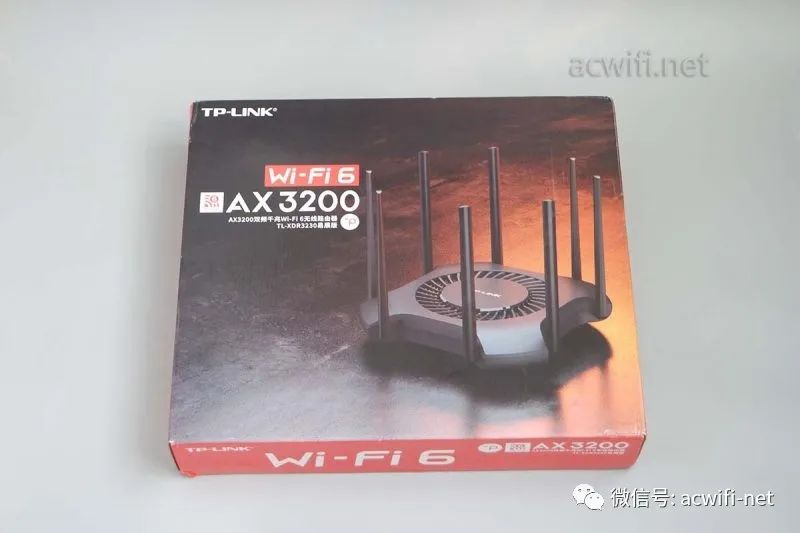
The package includes an Ethernet cable, a super five-category twisted pair, 26AWG gauge, which is fine for short runs, easily handling 10Gbps.
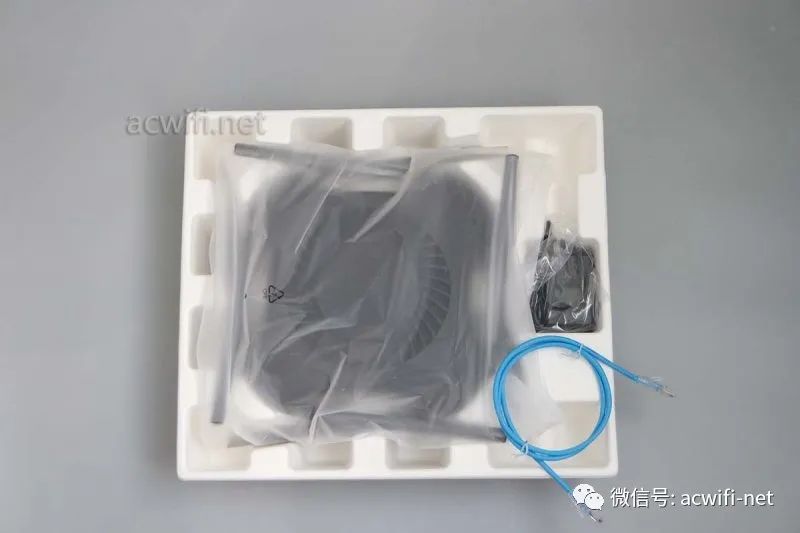
The power specification is 12V/2A, which is good, and the size is relatively large, which I think is great. The power consumption is determined by the router itself, not just the power supply. A 12V/2A power supply does not mean the router’s power is always 24W; do not misunderstand. A higher rated output power allows the power supply to handle peak power easily.
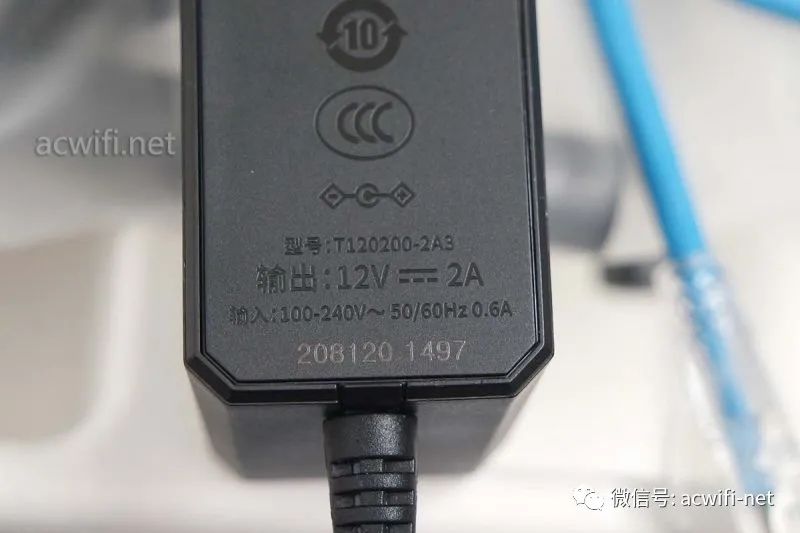
The appearance of the XDR3230 resembles a smaller version of the XDR6060, featuring a total of 8 external antennas, 4 for 2.4G and 4 for 5G.
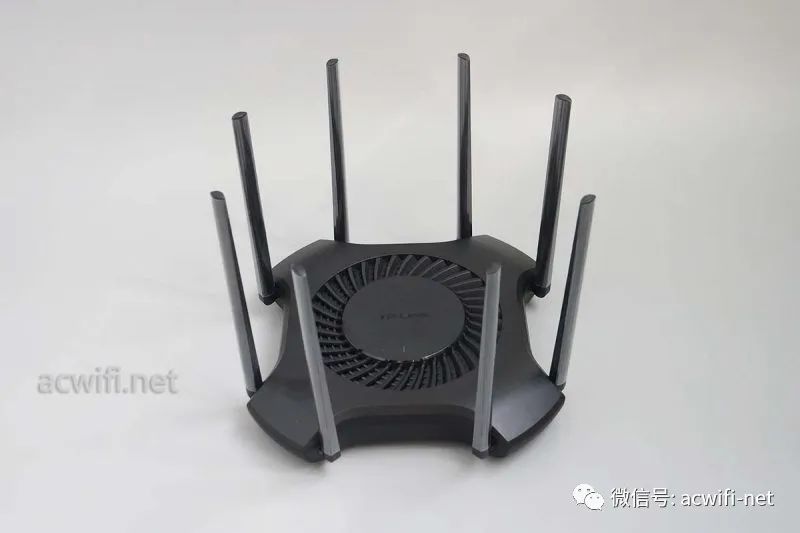
On the back, there are four full Gigabit Ethernet ports, with no distinction between WAN and LAN, supporting blind insertion. The “Easy Expand” networking button is located to the right of the RESET button.
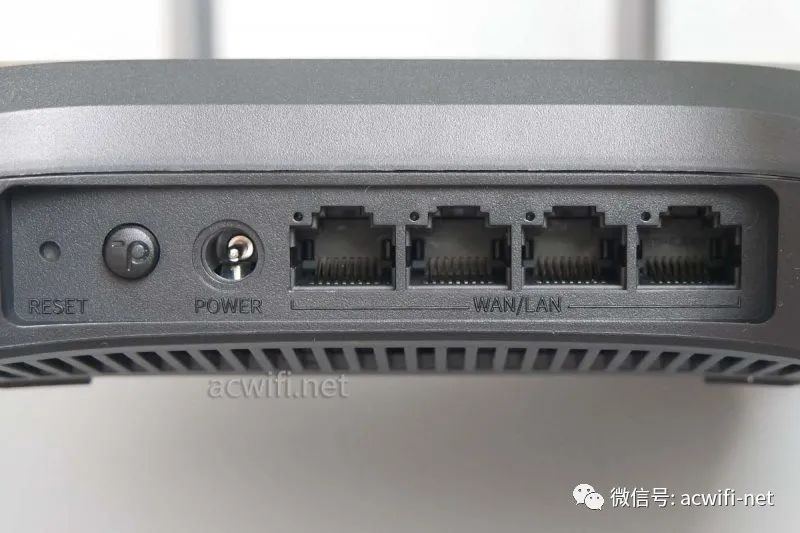
The Easy Expand networking supports up to 8 devices, as stated in the manual:
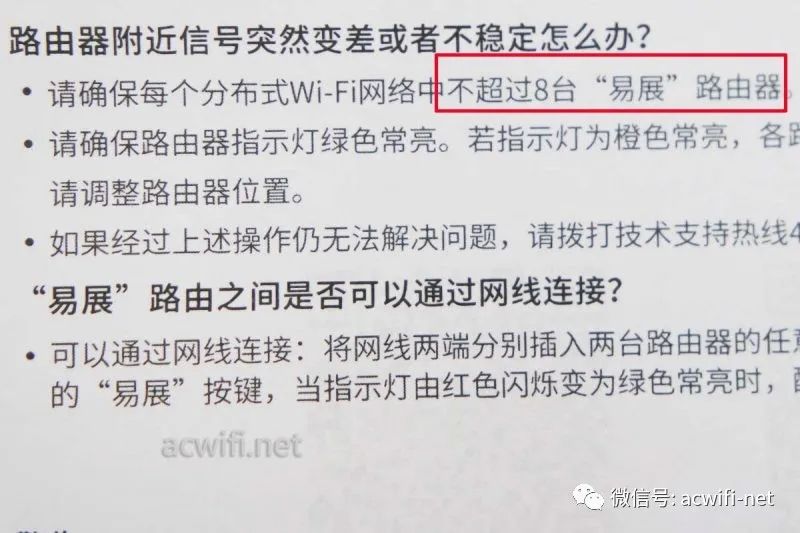
A few days ago, when disassembling the Mercury X188G, I also mentioned that it supports a maximum of 8 devices. A friend commented that Xiaomi cannot exceed 4 devices; if it does, it cannot form a network, as indicated by the interface:
“To ensure a good experience with the Mesh network, a maximum of 4 Mesh routers can be connected. For more Mesh routers, it is recommended to form a new Mesh network.”
I initially thought it was a suggestion not to exceed 4 devices, but it turns out it is a strict limitation. Why does the Velop, which also uses the Qualcomm platform, not have this restriction?
Starting the teardown, there is a screw under the label on the bottom of the device; just remove it. However, I cannot completely peel off the label without damaging it:
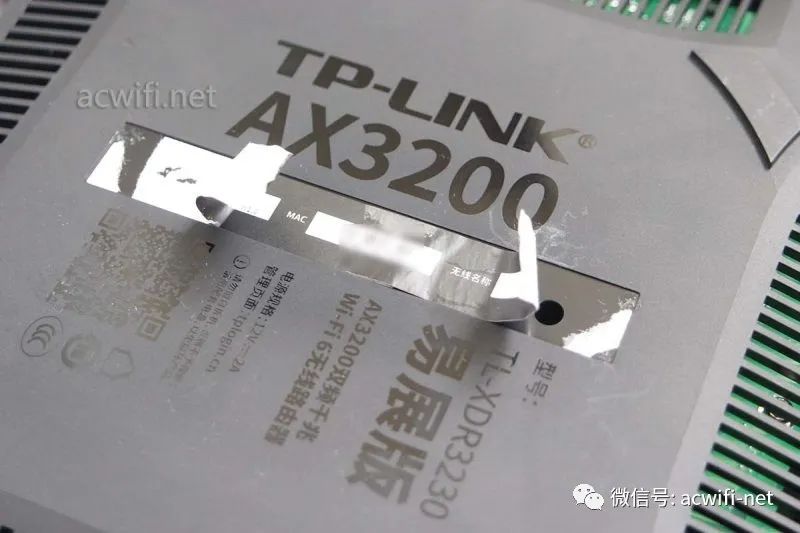
It is difficult to perform a damage-free teardown; even if I could peel it off completely, I would still break several clips when removing the outer shell, as more than half of the clips are glued. Opening the shell is already quite challenging. Sigh… Reassembling is quite easy, taking less than 5 seconds, but disassembling takes about 5 minutes.
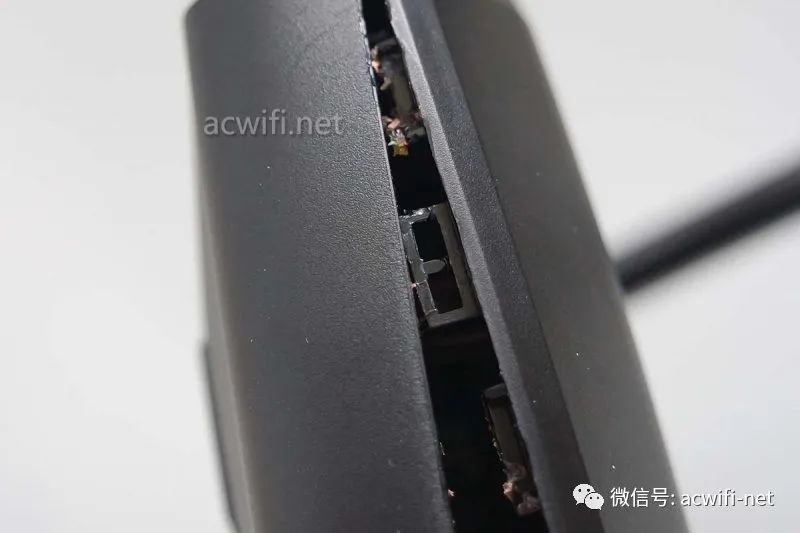
Finally, I managed to open it:
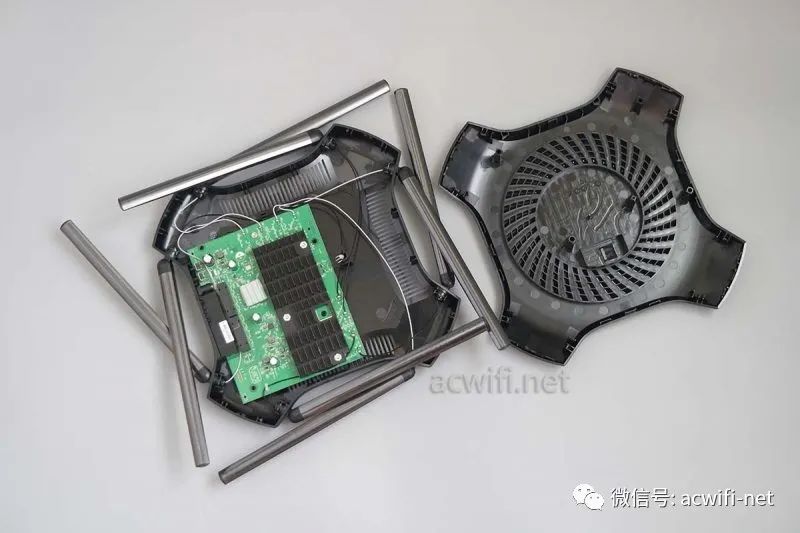
Glue-covered clips:
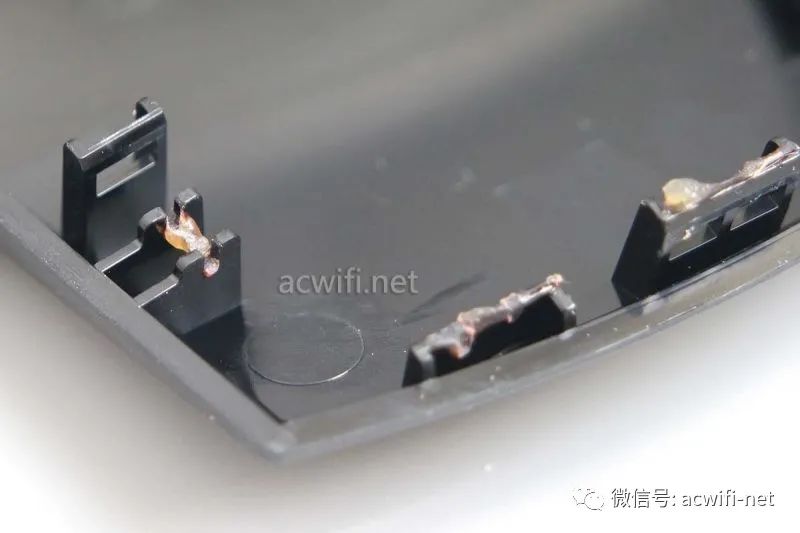
On the mainboard, there is a black aluminum heatsink, and above it is a ceramic heat sink. Could the chip below be the MT7621?
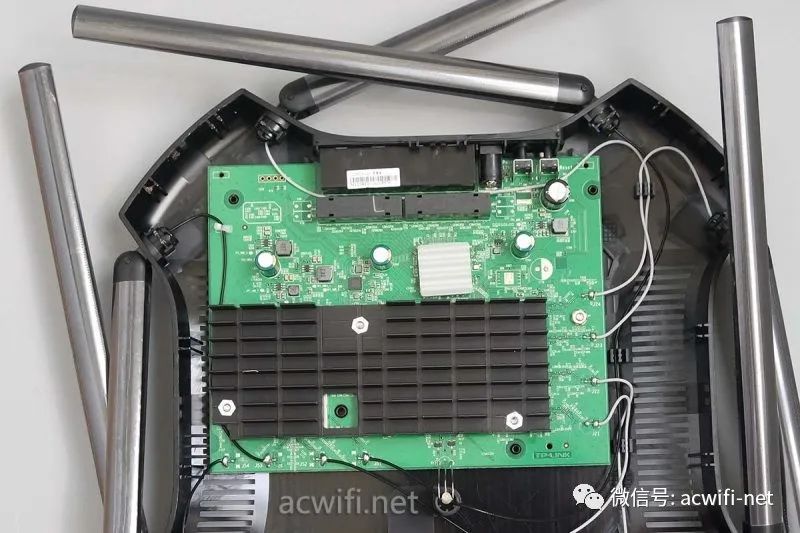
Eight antennas are soldered onto the mainboard, making it difficult to flip the board. After much effort to find the right angle, I finally managed to flip it over to see the back of the mainboard:
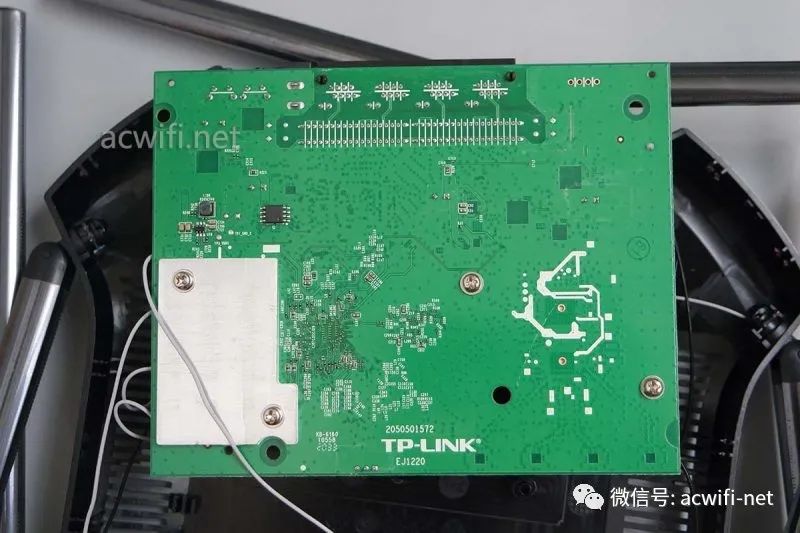
In the lower left corner of the image, there is a small aluminum plate. Typically, such small aluminum heat sinks are used to help dissipate heat from the power amplifier chip on the front of the mainboard. Above the heat sink is a flash memory chip, model EN25QH128A-104HIP, with a capacity of 16MB. Quite large, SPI 16MB, so flashing third-party firmware is promising, right?
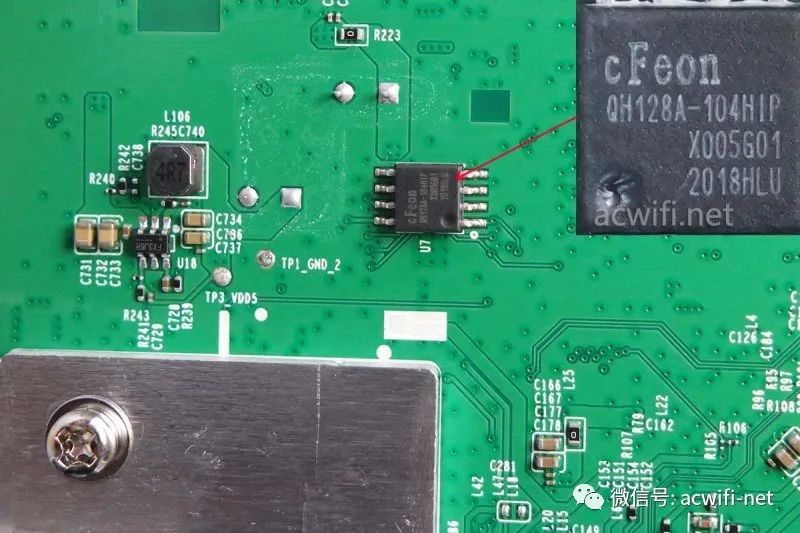
After unscrewing all the screws on the back of the mainboard, the heatsink on the front can also be removed. And this small aluminum plate looks like this after being taken off:
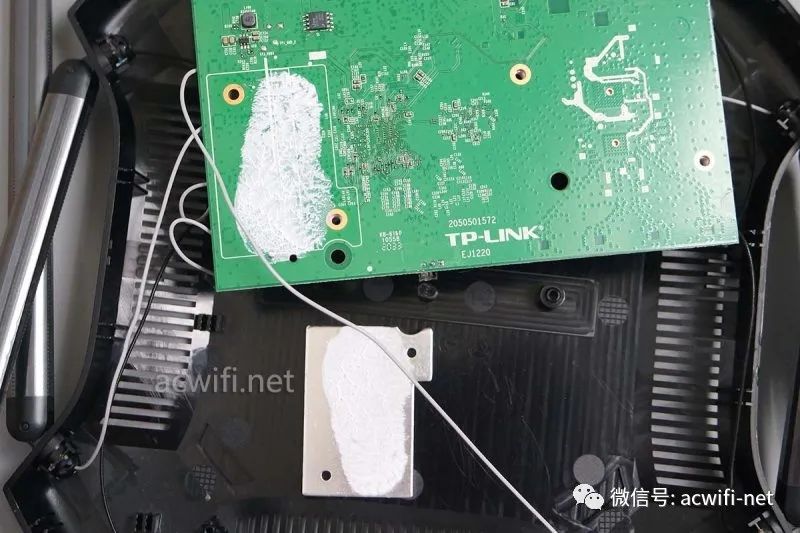
There is thermal grease, and to avoid dirtying my background cloth, I put the aluminum plate back. Now let’s flip it over to see the front of the mainboard, which looks like this after removing the heatsink:
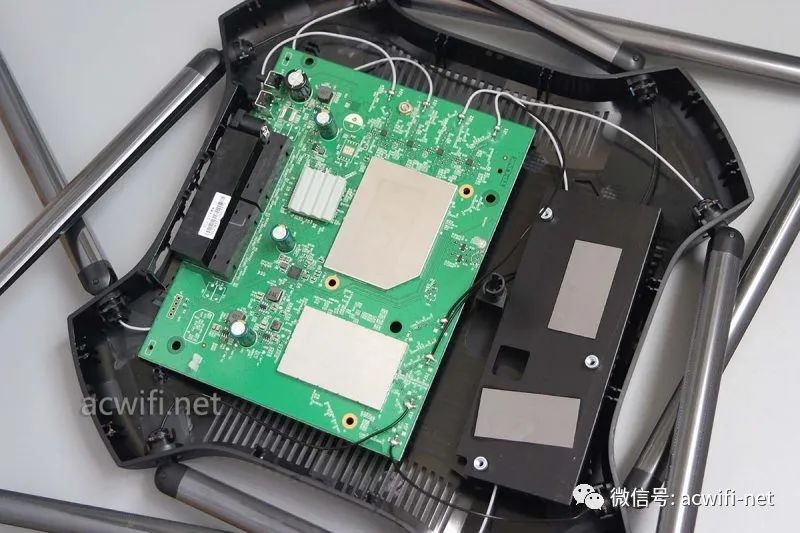
There are two shielding covers, and between them and the heatsink, there are thermal silicone pads, 1mm thick. This time it is much cleaner, unlike the XDR6060, XDR6030, and XDR5430, which were covered in thermal grease on the shielding covers, making the teardown very messy.
After removing the ceramic heat sink near the network transformer, I found a crab, which is not the CPU MT7621, but the gigabit switch chip RTL8367S. This means that there is definitely no MT7621, as the MT7621 itself integrates a gigabit switch. So what CPU is hidden under the shielding cover? I will pry open the shielding cover to find out.
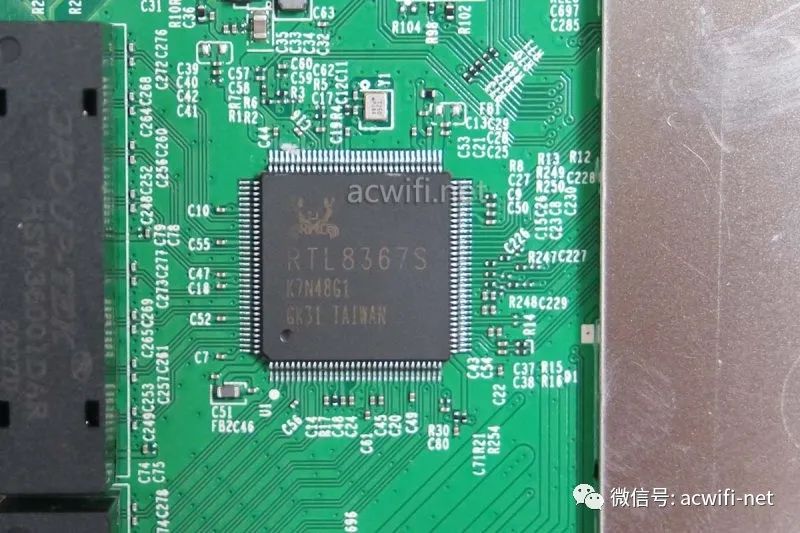
There is a small chip on the mainboard that caught my attention because I had never seen it before during previous teardowns. It is located above the two shielding covers and belongs to MEDIATEK’s MT6380N. From the circuit’s position, it looks like a power management chip, or PMIC for short.
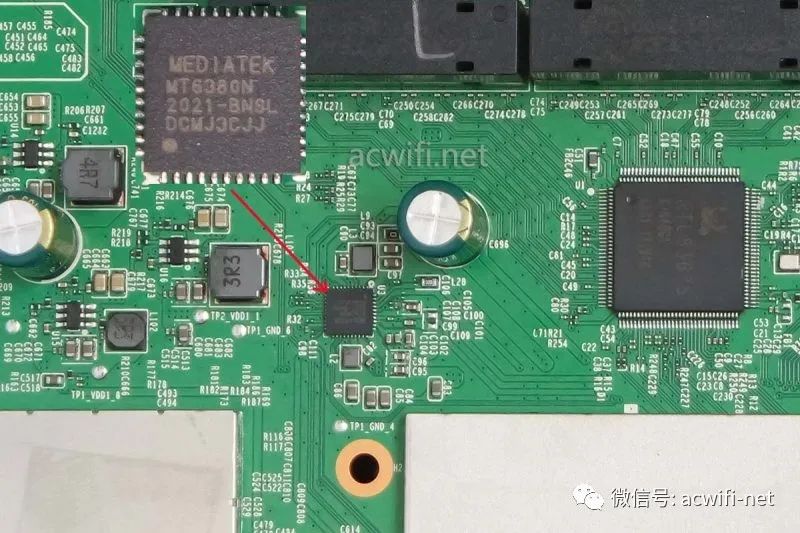
So I looked up some information and found the pinout diagram for the MT6380. Looking at the diagram, I wondered if I could lead out a few wires to connect to the USB port, thus enabling MTK PEP fast charging??? After waking from my dream, I counted the pins on the MT6380N on the board, and indeed, there are 10 pins on each side, totaling 40 pins, also in QFN packaging. It is indeed a power management IC, responsible for supplying power to the CPU.
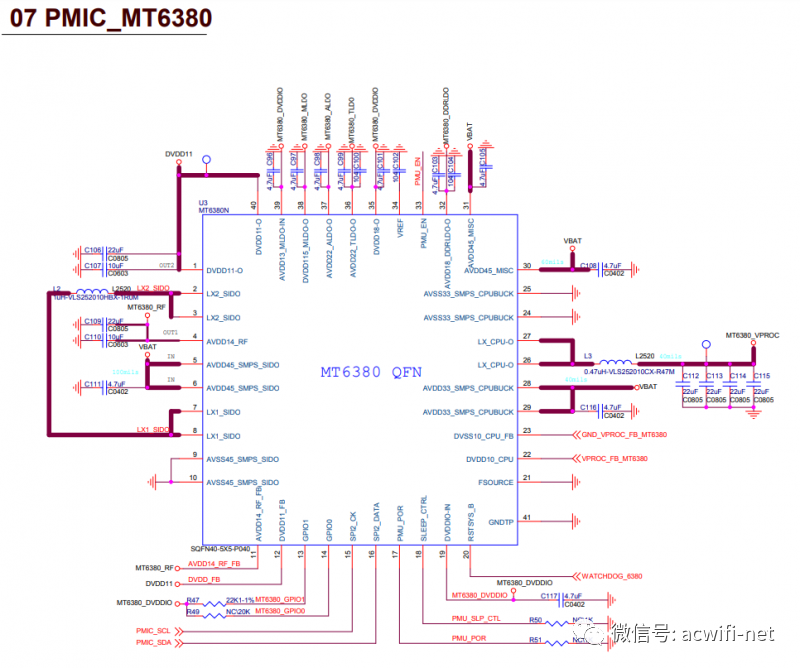
I am preparing to remove the two shielding covers, and the preparations are as follows:

Who said that using a suction cup can easily remove the shielding cover? It is useless. In my dream, Archimedes once told me that if he had a fulcrum, he could move the earth. So finding a fulcrum on the circuit board to pry open the shielding cover is not a problem. However, the mainboard usually has many small components and fragile traces, so I used this… I don’t remember where I took it from, but it is a white object I forgot to put back:
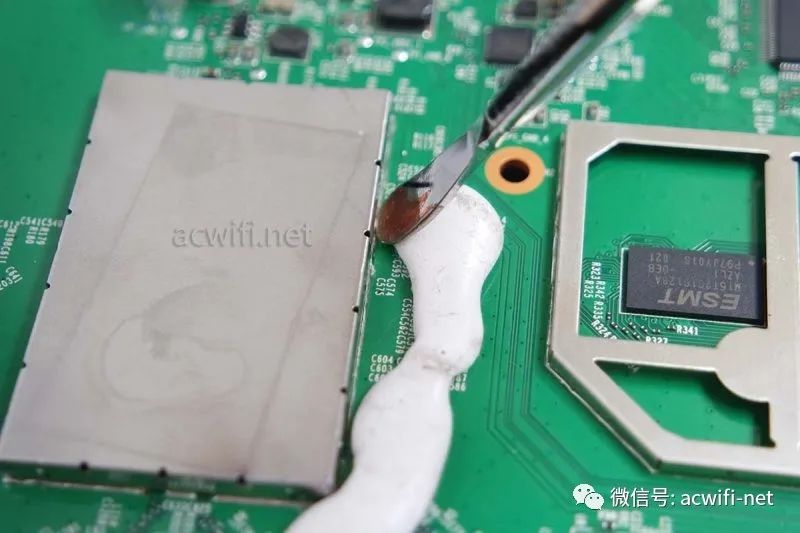
This way, I can easily pry it open without damaging the circuit board. Both shielding covers have been removed, and there are a total of 4 chips inside the shielding covers. Only the memory chip does not have a thermal silicone pad, while the other 3 chips do.
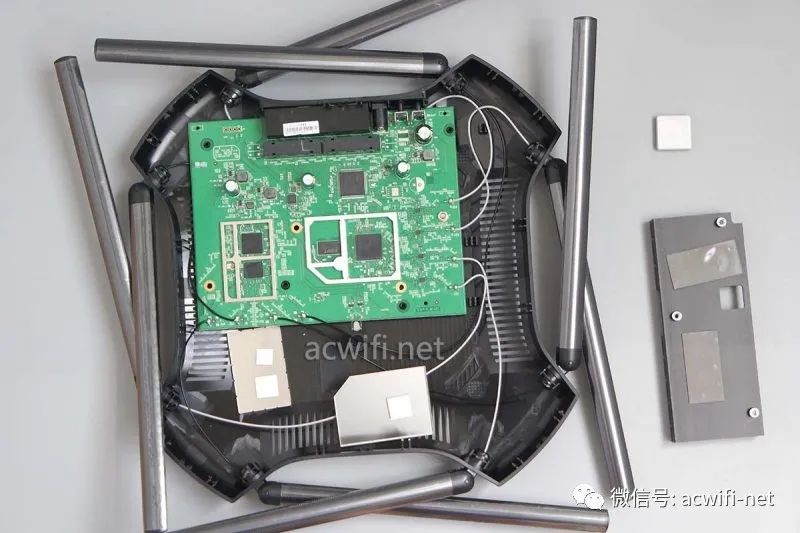
First, let’s see what the CPU is. The model is MT7622B, which I have never seen before. It is a dual-core 1.35GHz CPU, significantly higher in frequency than the MT7621’s 880MHz. The memory chip model is M15T2G16128A, with a capacity of 256MB, DDR3 memory.
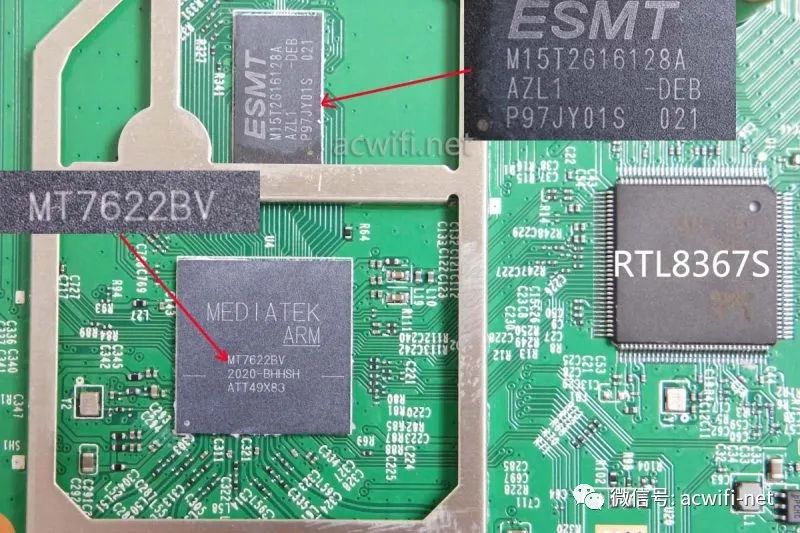
I looked up information on the MT7622. Here it is:
MT7622 is fabricated with advanced silicon process and integrates a Dual-core ARM® Cortex-A53 MPCoreTM operating up to 1.35GHz and more DRAM bandwidth. This SoC also includes a variety of peripherals, including SGMII, RGMII, PCIe2.0, USB2.0(Host), USB3.0(Host) ports, and 5-port 10/100 switch. To support popular network applications,
MT7622B also implements 2.5Gbps HSGMII and 1Gbps RGMII Ethernet interface, embedded a 5-ports 10/100 switch and 802.11n 2.4GHz 4T4R WLAN radio, 802.11ac WLAN connection can be supported through its PCIe port.
MT7622B has an HSGMII interface, which supports a transmission rate of 2.5Gbps. I also checked the RTL8367S information: “The RTL8367S also supports one Ser-Des interface that could be configured as SGMII/HSGMII interfaces.” It also has HSGMII, so the bandwidth between the CPU and the Ethernet port can reach 2.5Gbps. (The WAN port is connected with a 1Gbps rate RGMII.)
I mention this because the maximum rate of the XDR3230’s 5G is 2402Mbps. If two LAN ports transmit data to 5G simultaneously, can it reach its maximum speed? If the CPU only supports SGMII, the transmission rate would only be 1.25Gbps. Let’s test it after disassembly.
MT7622B integrates a 5-port 100Mbps switch, so the RTL8367S is needed to support gigabit Ethernet ports.
MT7622B integrates a 4×4 MIMO 2.4G, supporting 256-QAM, with a maximum rate of 800Mbps. (Using the ASUS PCE-AC88 to connect to the XDR3230’s 2.4G, the displayed rate is 800Mbps.)
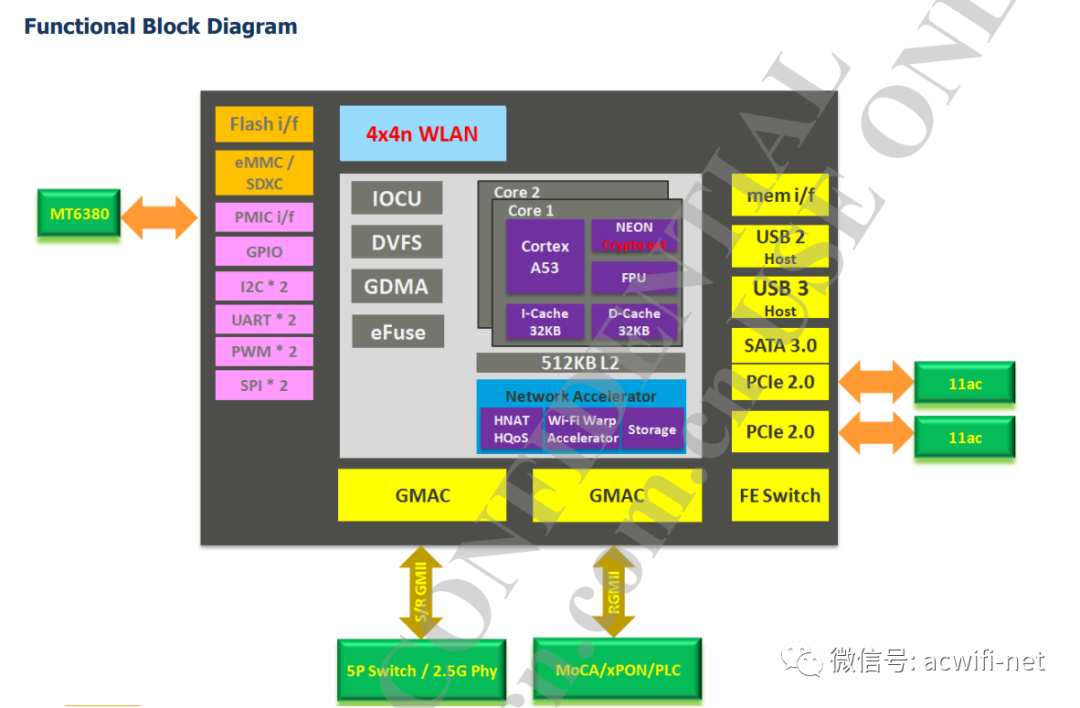
MT7622B integrates a 2.4G wireless chip, which means that the gigabit switch chip MT7530 had to be discarded. Otherwise, this CPU would overheat, and there might not be enough space to fit it in. Therefore, the RTL8367S is used externally.
The CPU-integrated 2.4G uses an external independent power amplifier chip, marked with 7626H, model RTC7626H, which is a 2.4G FEM chip.
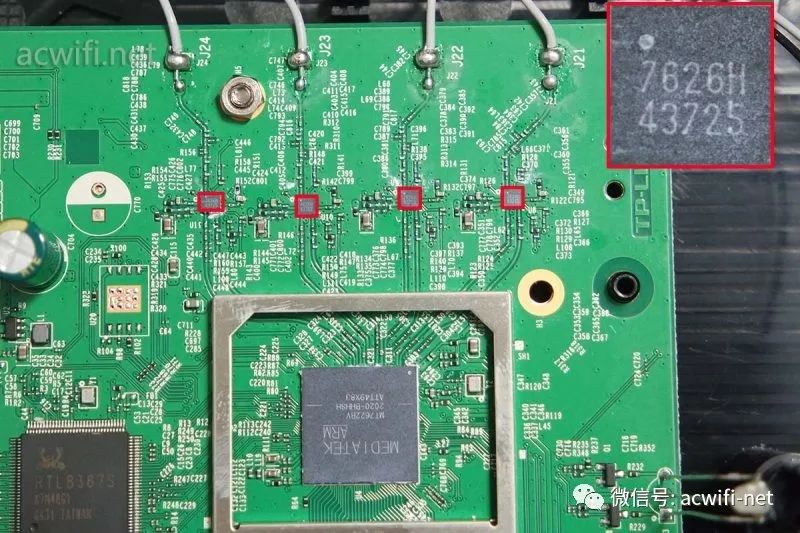
The parameters of RTC7626H are as follows:
Frequency range: 2.4 – 2.5 GHz 3 V to 5 V single supply voltage Integrated high performance PA, LNA with bypass function, and SP3T switch Input & output fully 50 ohm matching Integrated positive slope power detector +21 dBm linear output power at 3% EVM, 802.11g 64 QAM, 54 Mbps, 5 V Small 16L QFN 2.5×2.5×0.75 mm 3 package RoHS / Halogen Free Compliant Moisture Sensitivity Level: MSL 3
The amplification power is average.
Now let’s look at the 5G chip:
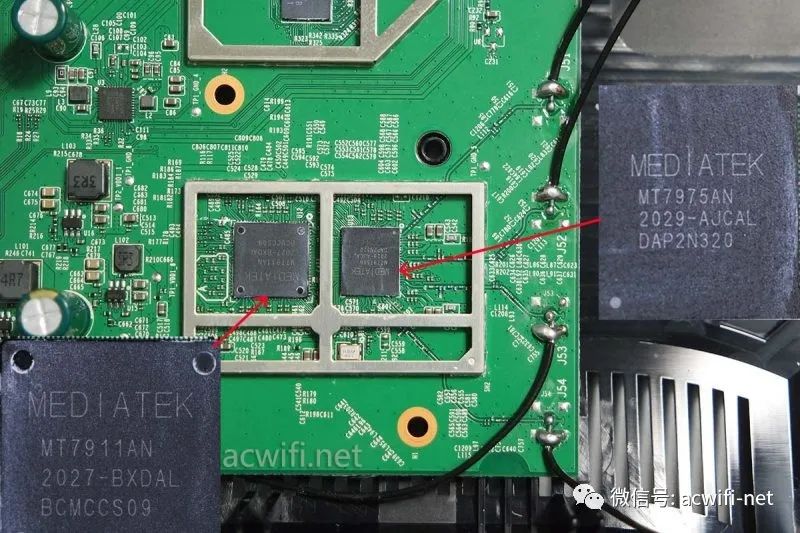
The 5G wireless circuit consists of two chips, MT7911AN and MT7975AN. Previously, MTK’s AX1800 solution used MT7905DAN + MT7975DN, where “D” indicates support for both 2.4G and 5G. The MT7615DN used in the Phicomm K2P follows the same principle.
It can be understood as:
MT7905DAN + MT7975DN = MT7915D, supporting dual-band 2×2 MIMO Wi-Fi 6;
MT7911AN + MT7975AN = MT7915A, supporting single-band 4×4 MIMO Wi-Fi 6.
A statement from MediaTek’s official website: MediaTek MT7915 integrates a simultaneous dual-band architecture that delivers multi-gigabit Wi-Fi speeds via either 4×4 (MT7915A) or 2×2 (MT7915D) antenna options.
I also found the MT7915 field in the TTL reading content of the XDR3230:
role_selection_wlan_ready_handle(472). [role selection] start bh apvap scan[ 27.983590] mt7915_apply_dpd_flatness_data: eeprom 0x62 bit 0 is 0, do runtime cal[ 27.991182] MtCmdChannelSwitch: control_chl = 48, control_ch2=0, central_chl =48 DBDCIdx= 0, Band= 1[ 28.000314] BW = 0, TXStream = 4, RXStream = 4, scan(1)[ 28.019624] *MtCmdChannelSwitch: control_chl = 4, control_ch2=0, central_chl =4 DBDCIdx= 0, Band= 0[ 28.028705] *BW = 0, TXStream = 4, RXStream = 4, scan(1)[ 28.147606] mt7915_apply_dpd_flatness_data: eeprom 0x62 bit 0 is 0, do runtime cal[ 28.155195] MtCmdChannelSwitch: control_chl = 149, control_ch2=0, central_chl= 149 DBDCIdx= 0, Band= 1[ 28.164500] BW = 0, TXStream = 4, RXStream = 4, scan(1)[ 28.191593] *MtCmdChannelSwitch: control_chl = 5, control_ch2=0, central_chl =5 DBDCIdx= 0, Band= 0[ 28.200646] *BW = 0, TXStream = 4, RXStream = 4, scan(1)[ 28.315598] mt7915_apply_dpd_flatness_data: eeprom 0x62 bit 0 is 0, do runtime cal
Dividing one MT7915 into two chips solves the heat dissipation problem and allows for flexible combinations.
Don’t blame me for being too verbose; if I could find detailed information about these chips online, I wouldn’t have to guess so hard, and I wouldn’t know if I was right or wrong.
From the 5G circuit in the image above, I did not see any external power amplifier chip, which is a bit disappointing. Based on previous tests of the XDR1860’s 5G, the signal was weak, and the speed was poor. The Redmi’s MT7615N can outperform the K2P’s MT7615DN, so let’s test it later to see how it performs.
There is a large capacitor, 16V 1000uF, and three 16V 470uF capacitors, providing sufficient power supply capability.
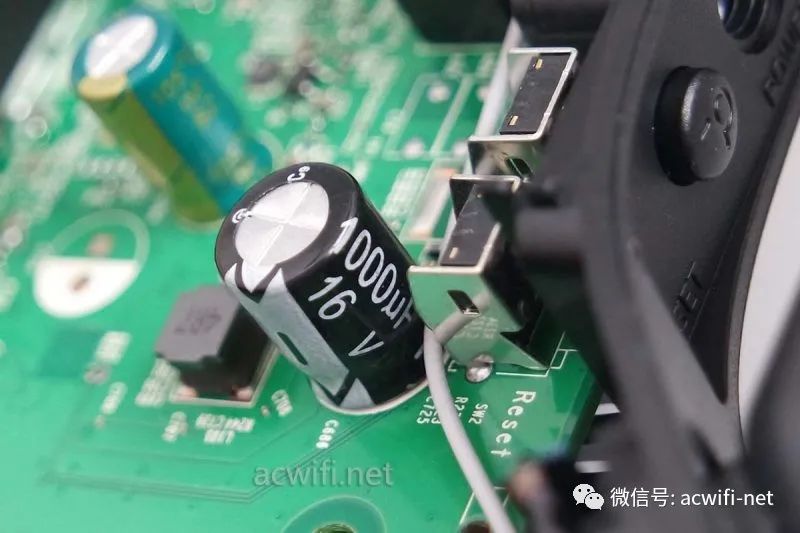
Above the CPU, there is an empty solder pad, which I suspect is for SPI flash:
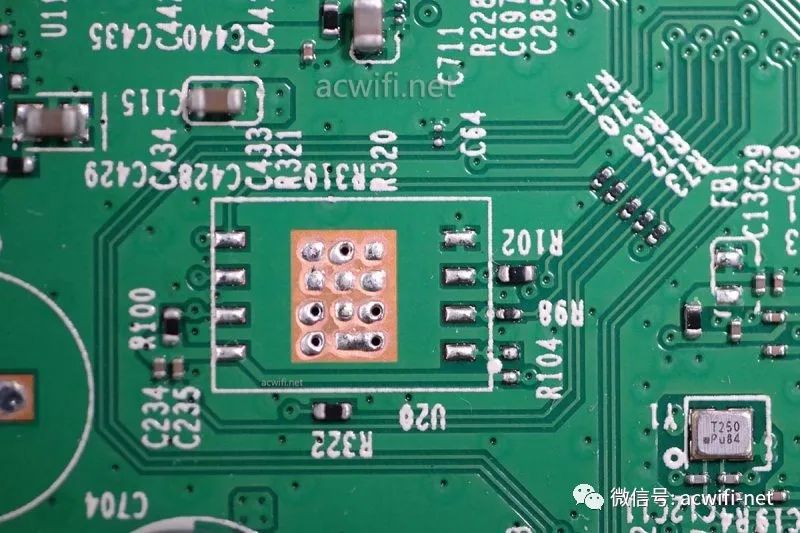
The TTL pin definitions of the XDR3230 are as follows: (baud rate 115200, Mercury is 57600)
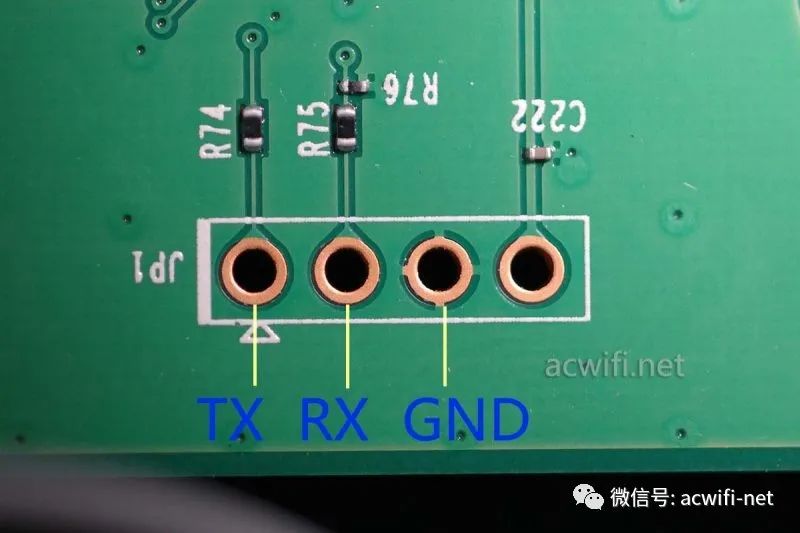
Finally, here is a summary image of the chip models:
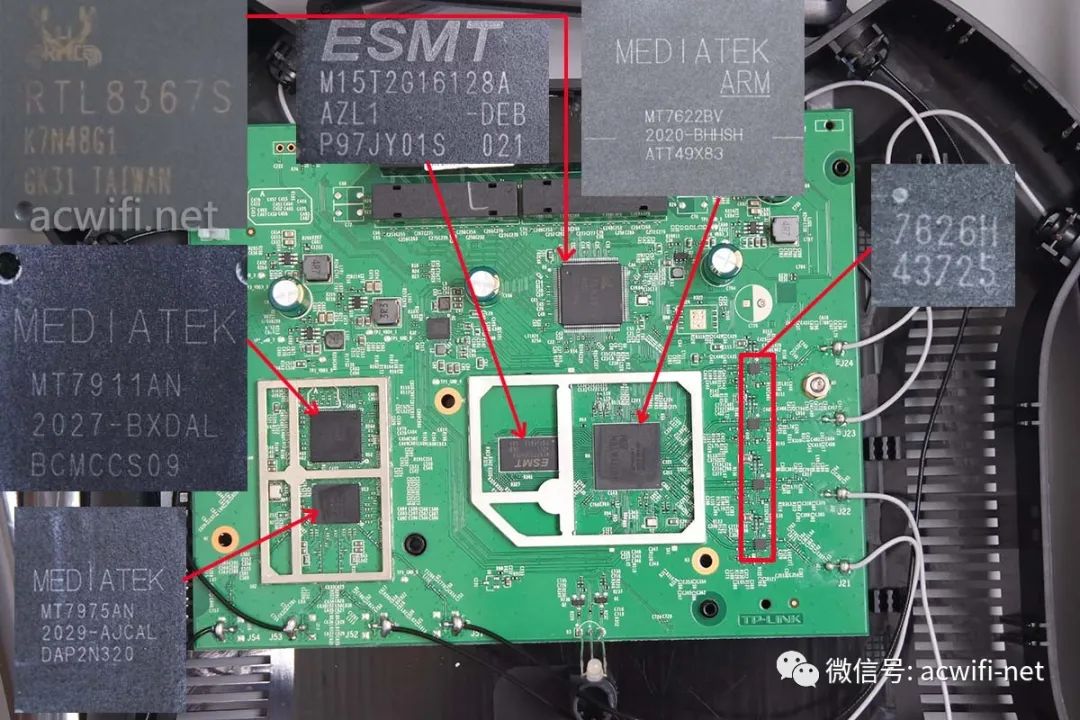
Thus, the teardown of TP-LINK’s XDR3230 is complete, but the article is not finished yet.
Although the 2.4G does not use a Wi-Fi 6 chip, it is worth noting that 2.4G is mostly reserved for smart devices. As long as the 2.4G signal is stable and strong, it is sufficient. Moreover, it has an independent FEM chip; even if the PA is not strong, the LNA increases sensitivity. Practical! For fast speeds, mobile devices need to connect to 5G Wi-Fi 6.
Next, I will conduct simple yet complex tests. There are two aspects to test: first, how high the maximum wireless speed of 5G can reach, and second, whether the 5G signal is stronger than that of the Mercury X188G.
Since it only has gigabit ports, I will use two LAN ports concurrently, and the receiving end needs to find a device that supports a 2.5GbE port. The TP-LINK XDR6060 is the most suitable, and the ASUS AX86U is also an option, but it has many issues with its 2.5GbE port. The general connection diagram of the devices is as follows:
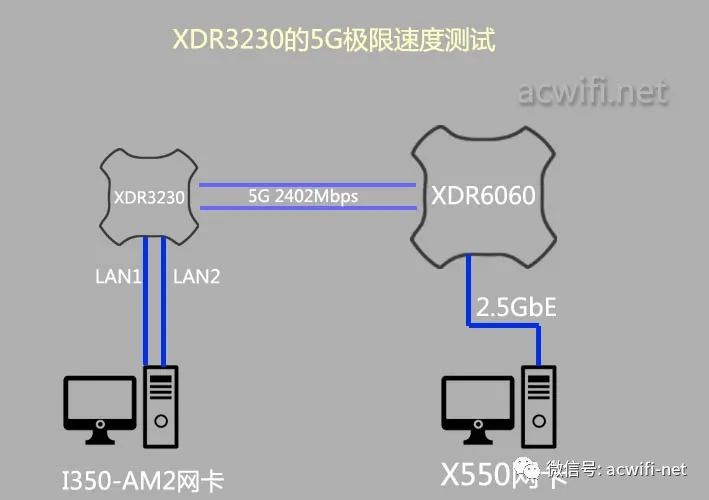
The XDR6060 wirelessly bridges the 5G of the XDR3230, with the maximum wireless connection rate between the two being 2402Mbps. Then, a computer is connected to the 2.5G port of the XDR6060, making the XDR6060 act as a wireless network card. The Intel X550 is a 10Gb network card that can recognize a 2.5Gbps port. This is the client, while the server is equipped with a dual-port gigabit network card with I350, connected to two LAN ports of the XDR3230, which is to test (LAN1 + LAN2) to 5G. The IxChariot test results are shown in the following image:
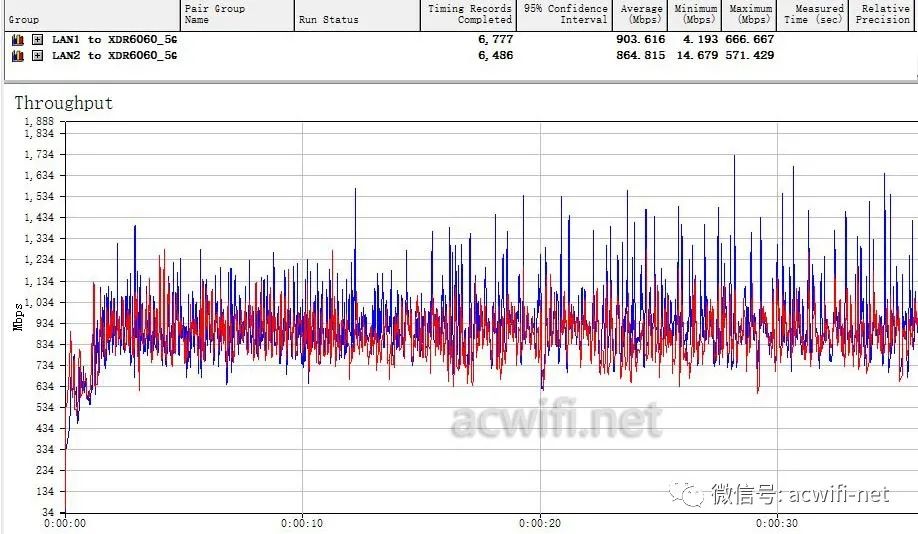
The total speed of the two LAN ports is 1768Mbps. I measured several times and took the maximum value this time; sometimes the total speed was just over 1000Mbps. I am not sure if it is due to the instability of its wireless or the instability of the wireless bridge. Then I used the ASUS AX86U to wirelessly relay the XDR3230, and at this point, I could not use the Intel X550 network card; I had to use the AQC107 to normally use its 2.5GbE port. The testing situation was similar.
Is 1765Mbps a good result? Normal.
This proves that the RTL8367S and MT7622B are using the HSGMII interface.
I will add 2.4G to the test to see how much the total dual-band wireless throughput can reach. I will open another computer, using the ASUS PCE-AC88 to connect to the XDR3230’s 2.4G, while the server uses the integrated network card on the motherboard connected to the third LAN port, running together with the 5G wireless bridge. The results are shown in the following image:
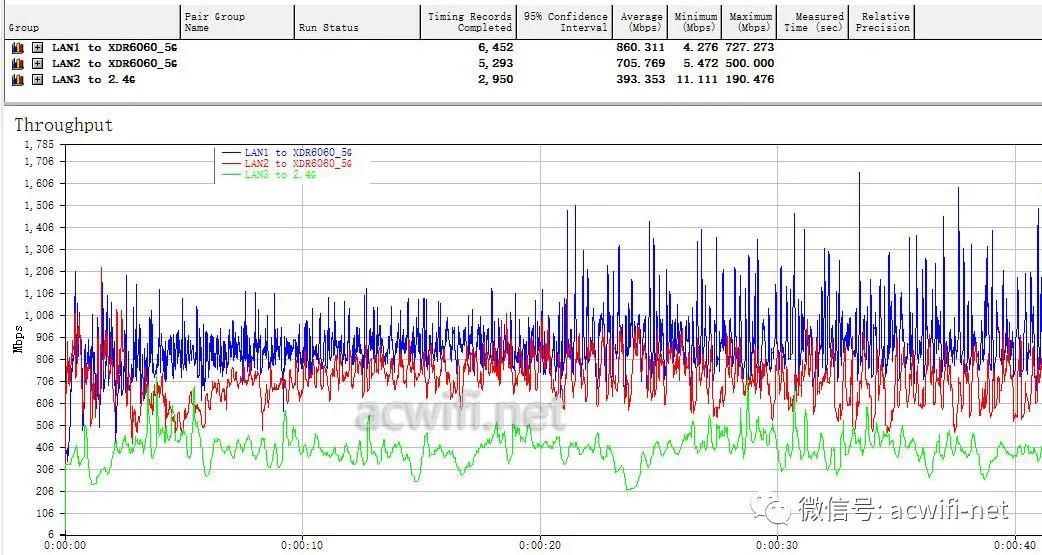
The total wireless throughput is… wait, let me take out the calculator to add it up. The result is 1959Mbps. Not bad, I don’t know how to evaluate the result since I have no reference.
Next, I will test the 5G signal strength and compare the results with those from the Mercury X188G test conducted a few days ago. I will also conduct a simple speed test using the Xiaomi 4C at points C and D (300Mbps broadband from China Telecom, 199 yuan per month, including 4 mobile cards, sharing unlimited 4G data, limited speed after 40GB). I will also test the power consumption under various conditions.
I have listed some hardware parameters and test results of the XDR3230 in the following image:
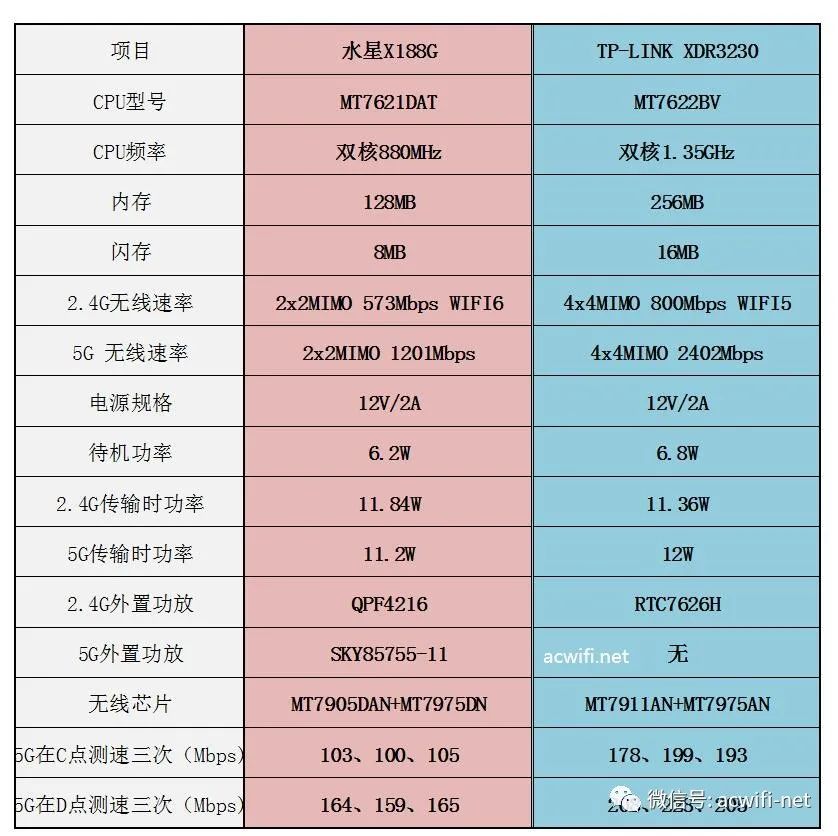
The 2.4G test speeds are similar, so I won’t elaborate. How should I put it? The XDR3230 has the shadow of the Redmi AC2100 and has potential. This is just a preliminary simple test; detailed evaluations will follow. This article is merely a teardown article; I can be very subjective in the teardown, but I must be very objective in the evaluation. To achieve objectivity and minimize errors, a lot of time and effort is required, so I am making excuses for the delay in releasing some evaluations.
Disadvantages: it does not support 160MHz bandwidth. If you need 160MHz bandwidth, you can buy the XDR5430 for an additional hundred yuan, but this XDR3230 has a good chance of being able to flash third-party firmware. The MT7622 is not a new CPU; it has been around since 2018. If firmware flashing is possible, the Wi-Fi 6 5G has a strong signal, and the 2.4G has an independent power amplifier, which is very practical.
It surprised me in two ways: first, the CPU is different from what I expected, but many people have already guessed it is the MT7622; second, the actual 5G performance is significantly stronger than I anticipated, only because the previous XDR1860 and X18G left me with a poor impression of 5G signals.
It is priced similarly to the Redmi AX6, so since they are the same price, a comparison test can be conducted. As for the timing, please refer to the previous three paragraphs for a statement. The teardown of the Redmi AX6, an old model Wi-Fi 6 wireless router.
Click on Read the original text to go directly to the XDR3230 product page on JD.com.